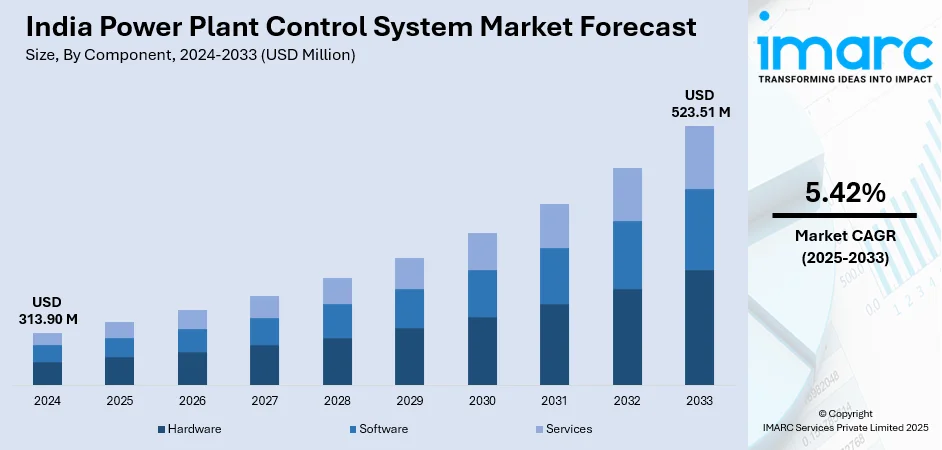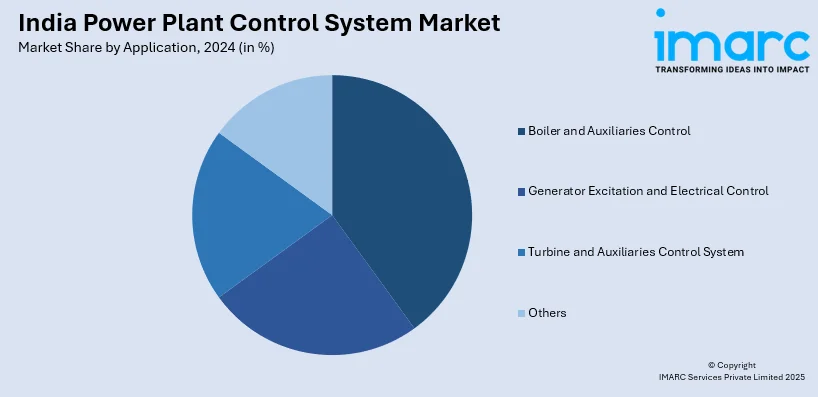
India Power Plant Control System Market Size, Share, Trends and Forecast by Component, Solution, Application, Plant Type, and Region, 2025-2033
India Power Plant Control System Market Overview:
The India power plant control system market size reached USD 313.90 Million in 2024. Looking forward, IMARC Group expects the market to reach USD 523.51 Million by 2033, exhibiting a growth rate (CAGR) of 5.42% during 2025-2033. Key factors driving the market include substantial renewable energy integration, rapid digitalization and smart automation, rising power demand, government initiatives for grid modernization, advancements in AI-driven predictive maintenance, growing investments in smart grids, and the rising need for enhanced energy efficiency and cybersecurity in power infrastructures.
|
Report Attribute
|
Key Statistics
|
|---|---|
|
Base Year
|
2024
|
|
Forecast Years
|
2025-2033
|
|
Historical Years
|
2019-2024
|
| Market Size in 2024 | USD 313.90 Million |
| Market Forecast in 2033 | USD 523.51 Million |
| Market Growth Rate 2025-2033 | 5.42% |
India Power Plant Control System Market Trends:
Increasing Renewable Energy Integration
India's power plant control system market is heavily influenced by the rapid growth of renewable energy, especially solar and wind power. The government's policy focus on the achievement of 500 GW of non-fossil fuel-based electricity generation capacity by 2030 has hastened investments in renewable energy infrastructures. Since solar and wind generation of power are by definition variable owing to changes in weather patterns, the demand for sophisticated control systems that maintain grid stability and enhance power distribution has increased. Advanced power plant control systems are the key to implementing renewable energy sources into India's grid without reducing stability. They use high-level automation, predictive analysis, and real-time monitoring to improve efficiency. They provide dynamic load balancing and smooth transmission of energy so that excess energy is stored or transmitted effectively. Moreover, microgrid innovation and smart grid development require advanced control systems that are capable of balancing renewable sources with traditional power plants.

To get more information on this market, Request Sample
Digitalization and Smart Automation
Another key driver propelling India's power plant control system market is the large-scale deployment of digitalization and smart automation technologies. The digital economy of India is expected to expand approximately twice as rapidly as the whole economy, making up for almost one-fifth of the national income by 2029-2030. As the energy sector gets modernized, power plants are moving from traditional manual modes to sophisticated digital control systems that increase efficiency, safety, and predictive maintenance. Supervisory Control and Data Acquisition (SCADA) systems, Distributed Control Systems (DCS), and Industrial Internet of Things (IIoT) solutions are becoming the cornerstone of Indian power plants. These technologies facilitate real-time data collection, remote monitoring, and automatic control of important plant operations, minimizing human intervention and operational risks. In addition, cybersecurity has emerged as a key factor in power plant digitalization. As cyberattacks on critical infrastructure pose growing risks, advanced security measures are being integrated into latest control systems to protect operations. Initiatives from the government, such as 'Digital India' and industry-level investments in smart grids, are further propelling the utilization of intelligent control solutions.
India Power Plant Control System Market Segmentation:
IMARC Group provides an analysis of the key trends in each segment of the market, along with forecasts at the region/country level for 2025-2033. Our report has categorized the market based on component, solution, application, and plant type.
Component Insights:
- Hardware
- Software
- Services
The report has provided a detailed breakup and analysis of the market based on the component. This includes hardware, software, and services.
Solution Insights:
- Supervisory Control and Data Acquisition (SCADA)
- Plant Asset Management (PAM)
- Distributed Control System (DCS)
- Programmable Logic Controller (PLC)
- Plant Lifecycle Management (PLM)
A detailed breakup and analysis of the market based on the solution have also been provided in the report. This includes supervisory control and data acquisition (SCADA), plant asset management (PAM), distributed control system (DCS), programmable logic controller (PLC), and plant lifecycle management (PLM).
Application Insights:

- Boiler and Auxiliaries Control
- Generator Excitation and Electrical Control
- Turbine and Auxiliaries Control System
- Others
The report has provided a detailed breakup and analysis of the market based on the application. This includes boiler and auxiliaries control, generator excitation and electrical control, turbine and auxiliaries control system, and others.
Plant Type Insights:
- Coal
- Oil
- Natural Gas
- Nuclear
- Hydroelectric
- Renewables
- Others
A detailed breakup and analysis of the market based on the plant type have also been provided in the report. This includes coal, oil, natural gas, nuclear, hydroelectric, renewables, and others.
Regional Insights:
- North India
- South India
- East India
- West India
The report has also provided a comprehensive analysis of all the major regional markets, which include North India, South India, East India, and West India.
Competitive Landscape:
The market research report has also provided a comprehensive analysis of the competitive landscape. Competitive analysis such as market structure, key player positioning, top winning strategies, competitive dashboard, and company evaluation quadrant has been covered in the report. Also, detailed profiles of all major companies have been provided.
India Power Plant Control System Market News:
- September 2024: Larsen & Toubro's Digital Energy Solutions division secured a contract to implement Energy Management Systems in 12 control rooms across Southern India's regional and state load dispatch centers, aiming to enhance grid efficiency and reliability. This initiative introduces advanced control technologies to the region's power infrastructure, promoting the adoption of modern control systems.
- July 2024: GreenPowerMonitor (GPM) introduced an advanced Energy Management System (EMS) to optimize renewable power plant operations using AI-driven automation and real-time data analysis. This system enhances grid stability by efficiently managing power dispatch schedules and adapting to fluctuating energy production.
India Power Plant Control System Market Report Coverage:
| Report Features | Details |
|---|---|
| Base Year of the Analysis | 2024 |
| Historical Period | 2019-2024 |
| Forecast Period | 2025-2033 |
| Units | Million USD |
| Scope of the Report |
Exploration of Historical Trends and Market Outlook, Industry Catalysts and Challenges, Segment-Wise Historical and Future Market Assessment:
|
| Components Covered | Hardware, Software, Services |
| Solutions Covered | Supervisory Control and Data Acquisition (SCADA), Plant Asset Management (PAM), Distributed Control System (DCS), Programmable Logic Controller (PLC), Plant Lifecycle Management (PLM) |
| Applications Covered | Boiler and Auxiliaries Control, Generator Excitation and Electrical Control, Turbine and Auxiliaries Control System, Others |
| Plant Types Covered | Coal, Oil, Natural Gas, Nuclear, Hydroelectric, Renewables, Others |
| Regions Covered | North India, South India, East India, West India |
| Customization Scope | 10% Free Customization |
| Post-Sale Analyst Support | 10-12 Weeks |
| Delivery Format | PDF and Excel through Email (We can also provide the editable version of the report in PPT/Word format on special request) |
Key Questions Answered in This Report:
- How has the India power plant control system market performed so far and how will it perform in the coming years?
- What is the breakup of the India power plant control system market on the basis of component?
- What is the breakup of the India power plant control system market on the basis of solution?
- What is the breakup of the India power plant control system market on the basis of application?
- What is the breakup of the India power plant control system market on the basis of plant type?
- What are the various stages in the value chain of the India power plant control system market?
- What are the key driving factors and challenges in the India power plant control system?
- What is the structure of the India power plant control system market and who are the key players?
- What is the degree of competition in the India power plant control system market?
Key Benefits for Stakeholders:
- IMARC’s industry report offers a comprehensive quantitative analysis of various market segments, historical and current market trends, market forecasts, and dynamics of the India power plant control system market from 2019-2033.
- The research report provides the latest information on the market drivers, challenges, and opportunities in the India power plant control system market.
- Porter's five forces analysis assist stakeholders in assessing the impact of new entrants, competitive rivalry, supplier power, buyer power, and the threat of substitution. It helps stakeholders to analyze the level of competition within the India power plant control system industry and its attractiveness.
- Competitive landscape allows stakeholders to understand their competitive environment and provides an insight into the current positions of key players in the market.
Need more help?
- Speak to our experienced analysts for insights on the current market scenarios.
- Include additional segments and countries to customize the report as per your requirement.
- Gain an unparalleled competitive advantage in your domain by understanding how to utilize the report and positively impacting your operations and revenue.
- For further assistance, please connect with our analysts.
 Request Customization
Request Customization
 Speak to an Analyst
Speak to an Analyst
 Request Brochure
Request Brochure
 Inquire Before Buying
Inquire Before Buying




.webp)




.webp)












